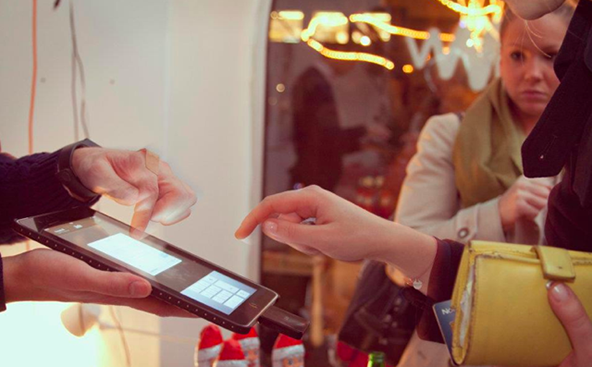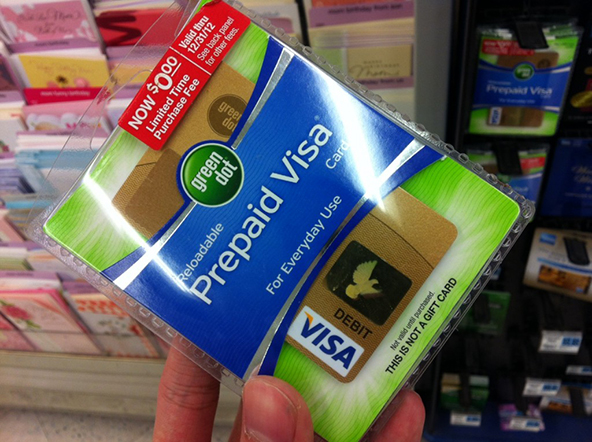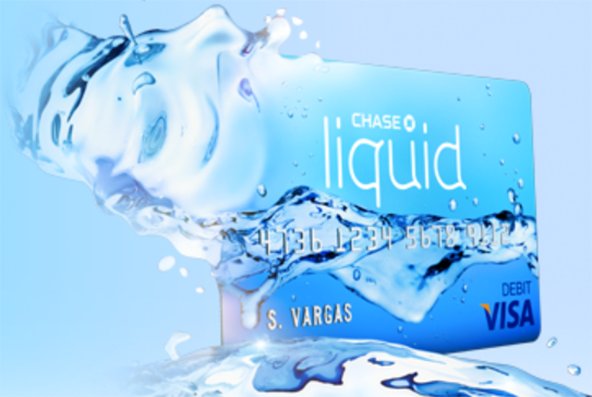Squaring up Mobile Payments in Europe

*Update: An iZettle representative has written in to address some of the issues that are discussed in this article. You can read her statement in the “Comments” section below the post.
Square, a service that enables consumers to accept credit and debit cards for payment through a reader attached to their smart phones, has done extraordinarily well in the U.S. since its launch in October 2010 and, if anything, has been going even stronger since one of the biggest names in the industry mounted a stiff challenge to its supremacy. Since PayPal launched its Square-like device two months ago, Jack Dorsey’s company has accelerated its growth, increasing the aggregate volume of processed transactions from $4 billion to $5 billion on an annualized basis in a single month, according to Bloomberg. I do have a slight preference for PayPal’s service, but I like both of them and the competition between the two will certainly benefit their American users.
But what about the rest of the world? Neither Square, nor PayPal Here is available to users outside of the U.S. and we don’t know whether either of them, or indeed any of their other U.S. rivals, has any plans to venture abroad anytime soon. What we do know, however, is that there is a Swedish start-up, called iZettle (it has no link to Apple), which has taken up the task and has just made its first foray outside of Scandinavia and into the U.K. I thought it was about time I said a few words about it.
What Is iZettle?
iZettle is a service which does the same thing that Square and PayPal Here do: enabling consumers, not just businesses, to accept card payments. However, iZettle users cannot accept Visa cards (as of the date of writing). At present, iZettle is only compatible with iPhones and iPads and it does not support Android-based devices.
The service was launched in May 2011 in Sweden and soon afterward it expanded into the other three Scandinavian countries: Norway, Denmark and Finland, before launching in the U.K. earlier this week. The company has signed up 50,000 users so far, according to various reports.
iZettle’s website is very sleek, as you might expect from a Swedish technology company. It is also very Square-like, which, I guess, Jack Dorsey should take as a compliment, while taking secret pleasure in the fact that his website still stands out head and shoulders above the competition.
The similarities between iZettle and Square are not confined to the two companies’ websites. Jacob de Geer, the co-founder and CEO of the Swedish company, sounds very much like Dorsey. Similarly to his American counterpart, de Geer is fond of pointing out that there are many millions (20 million by his count) of small businesses across Europe that are now only accepting cash, but would love to take cards, if only they could do it cheaply and conveniently. His following statement, as quoted by the Wall Street Journal, could easily have been uttered by Dorsey (in fact, I think Dorsey did say that):
If you are a plumber or an electrician, you could take a payment there and then, rather than have to invoice your customer and then wait for days for them to pay you.
Then there is this one, as quoted by Econsultancy.com:
The problem with chip and PIN is that you can’t target a large part of the retail industry as the sign up fees are too expensive. Then you also have subscription and transaction fees.
I am not intimately familiar with the European credit card processing landscape, but my limited observations suggest that a traditional merchant account is indeed a great deal costlier in Europe than it is in the U.S. But iZettle would remedy the situation by pulling a “Square” in Europe, we seem to be told. So how much does the Swedish processor charge?
How Much Does iZettle Charge?
When we attempt to answer this question, we immediately run into a problem. The company’s website says absolutely nothing about its fee structure. Now, I may have missed it, although I looked hard and long, but even if that were the case, it would still be inexplicable and inexcusable. iZettle’s fees must be clearly stated on the company’s website. There can be no acceptable explanation for not disclosing them.
As it is, we are left to rely on what others are telling us about iZettle’s fee structure. And, unsurprisingly, we hear different things from different sources. Econultancy.com, for example, tells us that “iZettle only charges transaction fees: 2.75% for MasterCard and Diner’s Club, or 2.95% for American Express.” Arcticstartup.com, on the other hand, claims that “users must only pay a 2.75% charge for MasterCard, Visa, or Diners Club card payments, or 3.75% for American Express.” Note that Visa isn’t even supported by iZettle.
So I’m not going to make any comments on iZettle’s fees, other than to urge the company to state them clearly and prominently on its website for everyone to see. If there are going to be different pricing models for different countries, say it and explain why. But don’t attempt to hide your pricing from your customers. They will find out soon enough anyway and all you can achieve by doing so is to set yourself up for a PR disaster.
The Takeaway
So it is clear that iZettle is still very much a work in progress. Apart from the pricing issue, the start-up is yet to add the biggest payment card brand to its list of supported cards and to enable payment acceptance on Android-based devices. These are all significant shortcomings and need to be addressed just as quickly as possible. So far, the start-up has benefited from the lack of competition, but if Square or PayPal entered the European market tomorrow, iZettle would quickly go the way of the dodo (or MySpace or Google Buzz, if you prefer). At the end, sleekness can only take you so far.
Image credit: Mutewatch.com.



According to the WSJ from yesterday, “there is no set up fee, or monthly payment. Instead, iZettle owners pay a fee of 2.75% per transaction.” They don’t mention American Express at all, but I suspect that they have overlooked it. It wouldn’t be the first time.
You haven’t written anything about the technology behind iZettle and that it differs from Square’s and PayPal’s in that it is designed to accept chip-and-PIN cards, not mag-stripe cards. That may be the reason why Square and PayPal haven’t been quick to move to Europe.
I agree, the contrast between iZettle and its American counterparts is huge when it comes to the pricing of their services. I don’t understand why iZettle is hiding it and has left to others to guess what it is. That’s a recipe for disaster.
How can they launch this thing without acceptance for Visa, which is several times as big as each of its competitors?! I’m sure they are trying, but they have to do better than that.
Yeah, everyone is left to figure out iZettle’s pricing on their own. According to Finextra, iZettle charges “2.75% of MasterCard, Visa or Diners Club card payments, or 3.75% of American Express payments” and they don’t accept Visa, so how can you believe that!? So what the iZettle guys are doing is really stupid and it’s so easy to correct it: just state your rates!
Given how huge Square has become in less than 2 years in the US I’m surprised that neither Square, nor PayPal has shown any interest in Europe. I wonder if it has anything to do with the chip-and-PIN technology.
I like what iZettle is doing. Starting up in Europe in times like these and expanding rather than hunkering down until the storm passes deserves some credit.
Hey guys,
Firstly, thanks for taking an interest in iZettle. We are always looking for feedback and would love to talk to you more. Feel free to drop me an email on Christina@izettle.com at anytime.
We have a few comments and would like to respond to your questions:
UK Market:
We haven?ÇÖt officially launched in the UK yet, we have just kicked off a closed beta programme to start testing the service in that particular market. It is an approach we take when we launch in a new country in Europe. We like to test the service and get feedback with a group of users before a commercial launch.
We have partnered with Mastercard, Diners Club and American Express to test the service in the UK. We are in talks with VISA Europe. We?ÇÖll keep you posted on our progress. We are hoping it will be onboard soon.
Comparisons to Square:
It is no secret that Square inspired iZettle. It is a great company that has paved the way for many other mobile payment companies including us. However, while we may look similar, our fundamental technology and security standards are dramatically different.
Square is for mag-stripe market and iZettle is for chip card market, which includes Europe, Asia and some parts of North and South America. Also, Europe introduced a chip card standard ?Çô EMV (Europay, MasterCard and VISA) – years ago to limit the risk of fraud and skimming. iZettle is EMV compliant.
Fees:
The European payments market is a different beast to America. As you would we expect, we have many different markets to navigate and each market has its own set of payment regulations – and each payment company has different fees in for different markets, which means iZettle transaction fees differ for each payment company in each market.
For example, the American Express transaction fee in the Nordic markets is 3.75% and 2.95% in the UK. Arcticstartup.com quoted the Nordic rate (as the guys writing the blog are based in the Nordics, Finland we believe) not the English rate in the recent article you referred to. This has now been changed – http://www.arcticstartup.com/2012/05/16/izettle-launches-smartphone-creditcard-reader-in-uk-market
Each country specific iZettle website states the local fees, however, we agree with you, the above reasoning should be laid out and easier to find on our main izettle.com website. We?ÇÖll work on this.
Users:
Above you mention we have signed 50,000 users. To clarify 50,000 merchants use our service in the Nordic markets where we have officially launched and are an established user to small businesses. These figures do not include UK users as we are just testing the service over here at the moment.
We are absolutely a work in progress (as we believe all good companies should be :) – so thank you for helping us by providing feedback, we value it highly and let me know if you have any further questions.
Christina
@iZettle
@Christinasdiary
PS Are any of you based in the UK? Would you like to be a part of our beta programme over here? We?ÇÖd love to have you test the service and keep getting your feedback.
Hello Christina,
I appreciate your comments and will leave it to our readers to interpret them as they will. I am fully aware that your service is designed for the EMV technology, not for the one based on the magnetic stripes that we use here in the U.S., but didn’t mention it in my article, because I didn’t see the need for it. If Square or PayPal decided to enter the European market, they wouldn’t have any problem devising an EMV-compliant card reader.
In regards to your fees, I suspected that there might be regional differences, but still believe that you should list your fees on your website; if you have to do so for each individual market, so be it.
I do want to conclude by saying that I wish your company the best of luck and will follow up with an email on your beta-test offer.
I love that there are people innovating in payments and trying to break through the ancient methods used on cards not even accounting for crazy fee structures.
The issue I see with iZettle or Square or anyone going to Europe for card acceptance is EMV. What we might call chip+pin here. It seems that iZettle reads the card but does not implement chip+pin which is what actually reduces fraud. I’m not sure you can execute chip+pin due to EMV’s stringent requirements for pin input not being on a virtual pin pad (not 100% clear). Not being an iZettle hater, again anyone innovating in payments is ok with me, but with payments, the devil is in the details and I see US based VCs and analysts getting duped by supposed simple “solutions.” (not saying this is the case for iZettle)
A final thought and I might have missed it, Android support? Is seems to be as the name might imply they don’t support Android phones. As an iPhone user, I am not totally shocked as supporting the myriad versions of Android devices can get costly with various dongles and such.
I wish the best of luck to all the payment innovators and hope these hurdles can be overcome.
Hi Dion,
According to EMV (Europay Mastercard Visa ?Çô the global standard for chip card payments) there are several methods for verifying a cardholder. One is PIN and another is signature. PIN entry must only be conducted on PIN entry terminals that are certified as compliant with the Payment Card Industry PIN Transaction Security (PCI PTS) requirements. ?áCurrently, the key pads or touch screens on mobile devices are not capable of complying with the PCI PTS requirements. Hence, signature is the approved and safe solution in iZettle’s case.
In addition, we can report that our fraud rate in the Nordics is well below industry average.
We are working on Android solution. Stay tuned :).
Christina
iZettle UK
I am not excited by the prospects of another Square, even if ti is across the Atlantic. The one we have here is a joke. They do not have enough staff to handle customer inquiries and they hold your money for no reason. In my case, I am still waiting for my money to be released. It’s been a disaster.